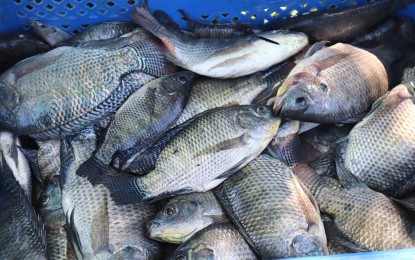
EL NINO PREPARATION. The Department of Agriculture (DA) in the Cordillera Administrative Region continues to advice farmers, even those who are into aquaculture, to diversify and choose plants and animals that need less water to cushion the impact of the projected El Niño. The peak of the dry spell is expected to start in November until the first quarter of 2024. (Photo by Liza Agoot)
BAGUIO CITY – The Department of Agriculture continues to advise farmers to grow short gestation plants and those that do not require so much water ahead of the El Niño’s projected start in November until the first quarter of 2024.
Aida Pagtan, Regional Agriculture and Fisheries Information Service (RAFIS) chief, told the Philippine News Agency on Wednesday that DA continues to inform farmers of various ways to cushion the effects of El Niño.
El Niño is characterized by low to zero rainfall and temperature that is higher than usual.
For the agricultural sector, plants usually wither due to the heat, requiring more frequent watering as a result of high chances of evaporation.
Pagtan said the dry spell is a natural phenomenon that can be cushioned by adopting systems such as growing plants that do not require so much water and those needing only a shorter time to harvest.
For animal farming, she said the effects of El Niño can also be lessened by feeding cows with corn and sugarcane as well as legumes, which are good sources of protein for animals.
“They can seek help from the provincial agriculture offices for artificial insemination as heat lowers the chance of an animal getting pregnant,” she shared.
For fisheries, the recommendation is to choose tilapia and bangus (milk fish) since these are resistant to heat, as well catfish and mudfish which lives and thrives in muds.
The National Irrigation Administration (NIA) has also recommended the diversification of crops, especially in Benguet province, like corn, carrots, cabbage, beans, tomato, squash, broccoli, sweet peas, onion leeks, and radish, all of which have low water demand compared to rice.
Engr. Chrisanta Beray, chief of operations of the NIA-Cordillera, in a report shared on Wednesday also recommended the utilization of early maturing and drought-resistant plant varieties as well as the adoption of a rotational schedule of water delivery for hosed farmlands.
She said the 2,848.89 hectares of farmlands serviced by the NIA in the provinces of Abra, Apayao, Ifugao, and Kalinga, as well as the community irrigation systems in Abra, Apayao, Benguet, Ifugao, Kalinga, and Mountain Province have a high risk of being affected by the dry spell, necessitating that farmers prepare and look for alternative sources of water.
“Pumped-water as augmentation or sourcing water by pumping them from the nearby creeks or underground can be resorted to avoid disruption of the planting season,” she said. (PNA)
